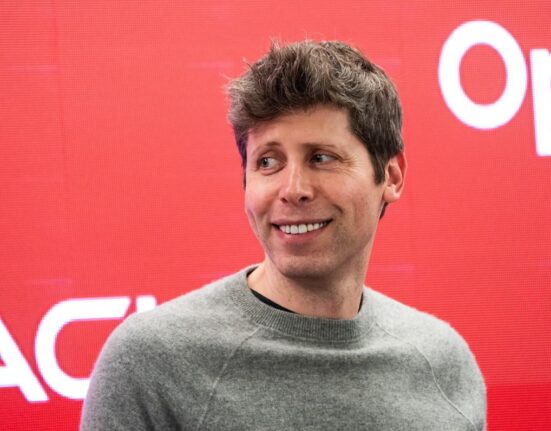Welcome to Eye on AI, with AI reporter Sharon Goldman. In this edition…Open AI’s gigawatt arms race is underway in Abilene, Texas…Nscale announces record-breaking $1.1 billion Series B...OpenAI and Databricks strike AI agent deal…Trump administration will provide Elon Musk’s xAI to federal agencies.
Sam Altman stood outside Building 2 at OpenAI, Oracle, and SoftBank’s flagship Stargate data center in Abilene, Texas. He — along with the cluster of journalists peppering him with questions — looked small against the backdrop of the sprawling 800-acre site, swarming with thousands of construction workers and dotted with spools of fiber cable, steel beams, water pipes, and heavy machinery.
As I reported on Tuesday, we were there for a media event to tout the progress of the high-profile and ambitious “Stargate” AI infrastructure project. OpenAI and Oracle announced an expansion of the Abilene site, plus plans to build five massive new data center complexes across the U.S. over the next several years. Altogether, the initiative represents hundreds of billions of dollars in investment — a project of mind-boggling scale. In Abilene alone, a crew of 6,400 workers has already flattened hills by moving mountains of soil and laid enough fiber optic cable to wrap the Earth 16 times.
“We cannot fall behind in the need to put the infrastructure together to make this revolution happen,” Altman told reporters during the media event, which also included Clay Magouryk. one of Oracle’s two new CEOs, as well as Texas Senator Ted Cruz. “What you saw today is just a small fraction of what this site will eventually be — and this site is just a small fraction of what we’re building. All of that still won’t be enough to serve even the demand of ChatGPT,” he added, referring to OpenAI’s flagship product.
Altman and OpenAI have been relentless in their drive to “scale compute.” By this, they don’t mean chasing the next algorithmic breakthrough or elegant line of code. They mean brute industrial force: millions of chips, sprawling campuses wired with fiber, and gigawatts of electricity — along with the gallons of water needed to help cool all that equipment. To OpenAI, scaling compute means piling on ever more of this horsepower, betting that sheer scale — not software magic — is what will unlock not just artificial general intelligence (AGI), which the company defines as “highly autonomous systems that outperform humans at most economically valuable work,” but what it calls artificial super intelligence (ASI), that would hypothetically surpass human capabilities in all domains.
Welcome to Eye on AI, with AI reporter Sharon Goldman. In this edition…Open AI’s gigawatt arms race is underway in Abilene, Texas…Nscale announces record-breaking $1.1 billion Series B...OpenAI and Databricks strike AI agent deal…Trump administration will provide Elon Musk’s xAI to federal agencies.
Sam Altman stood outside Building 2 at OpenAI, Oracle, and SoftBank’s flagship Stargate data center in Abilene, Texas. He — along with the cluster of journalists peppering him with questions — looked small against the backdrop of the sprawling 800-acre site, swarming with thousands of construction workers and dotted with spools of fiber cable, steel beams, water pipes, and heavy machinery.
As I reported on Tuesday, we were there for a media event to tout the progress of the high-profile and ambitious “Stargate” AI infrastructure project. OpenAI and Oracle announced an expansion of the Abilene site, plus plans to build five massive new data center complexes across the U.S. over the next several years. Altogether, the initiative represents hundreds of billions of dollars in investment — a project of mind-boggling scale. In Abilene alone, a crew of 6,400 workers has already flattened hills by moving mountains of soil and laid enough fiber optic cable to wrap the Earth 16 times.
“We cannot fall behind in the need to put the infrastructure together to make this revolution happen,” Altman told reporters during the media event, which also included Clay Magouryk. one of Oracle’s two new CEOs, as well as Texas Senator Ted Cruz. “What you saw today is just a small fraction of what this site will eventually be — and this site is just a small fraction of what we’re building. All of that still won’t be enough to serve even the demand of ChatGPT,” he added, referring to OpenAI’s flagship product.
Altman and OpenAI have been relentless in their drive to “scale compute.” By this, they don’t mean chasing the next algorithmic breakthrough or elegant line of code. They mean brute industrial force: millions of chips, sprawling campuses wired with fiber, and gigawatts of electricity — along with the gallons of water needed to help cool all that equipment. To OpenAI, scaling compute means piling on ever more of this horsepower, betting that sheer scale — not software magic — is what will unlock not just artificial general intelligence (AGI), which the company defines as “highly autonomous systems that outperform humans at most economically valuable work,” but what it calls artificial super intelligence (ASI), that would hypothetically surpass human capabilities in all domains.











Leave feedback about this